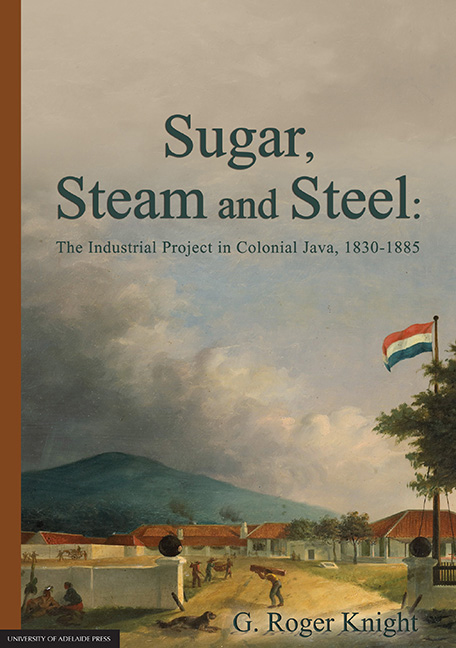Book contents
- Frontmatter
- Contents
- Abbreviations and Glossary
- Acknowledgements
- Introduction: Java Sugar, an Industrial Project and the ‘Oriental Cuba’, 1830-85
- Part I The ‘Industrial Revolution’ in Sugar Manufacture
- Part II The ‘Peasant’ Economy, the Money Trail and the Bourgeoisie
- Part III Metamorphosis
- 6 Metamorphosis: Machinery, Science and the Manufacture of Sugar in Java on the Eve of the Crisis of the Mid-1880s
- Conclusion: The Future of an Industrial Project: The 1880s and Beyond
- Archival Sources
- Bibliography
6 - Metamorphosis: Machinery, Science and the Manufacture of Sugar in Java on the Eve of the Crisis of the Mid-1880s
from Part III - Metamorphosis
Published online by Cambridge University Press: 24 October 2017
- Frontmatter
- Contents
- Abbreviations and Glossary
- Acknowledgements
- Introduction: Java Sugar, an Industrial Project and the ‘Oriental Cuba’, 1830-85
- Part I The ‘Industrial Revolution’ in Sugar Manufacture
- Part II The ‘Peasant’ Economy, the Money Trail and the Bourgeoisie
- Part III Metamorphosis
- 6 Metamorphosis: Machinery, Science and the Manufacture of Sugar in Java on the Eve of the Crisis of the Mid-1880s
- Conclusion: The Future of an Industrial Project: The 1880s and Beyond
- Archival Sources
- Bibliography
Summary
In July 1870, the fifty-year-old Jan Louis van Gennep, President [CEO] of the NHM's Batavia factorij, left Batavia by coastal steamer to begin a tour of inspection of his company's investments on the island's Northeast Coast. On his way back, he travelled inland through the Vorstenlanden of South-Central Java. Late in the month, having arrived by rail on a recently opened section of the line being built from the Vorstenlanden down to the coast at Semarang, he stayed for some days at the Courtcity of Surakarta (Solo). The city, the seat of the Soesoehoenan, head of one of South-Central Java's two ruling families, was also at the centre of a considerable belt of plantation activity that had begun there several decades earlier, in which coffee, indigo and sugar were well to the fore.
Commensurate with his important position in colonial circles in the Indies, van Gennep, an old Indies hand who (as we saw earlier) had been in Java for over a quarter of a century, evidently spent some time with the Resident Tobias, the Dutch representative at the Soesoehoenan's Court. Indeed, he may well have stayed with the Resident, and it was presumably Tobias who suggested that he might visit the Colomadu factory at Malangjiwan, a few kilometres to the east of the city. This enterprise was unusual in that it was the only industrial sugar factory in the colony owned by a Javanese, having been established almost ten years earlier by the Solonese aristocrat, Pangeran Adipati Ario Mangkunegra IV, in whose Principality it stood. What made Colomadu even more unusual, however, was that it also boasted the first ‘Triple Effet’ apparatus — the sine qua non of ‘modern’ sugar manufacturing from the 1860s onward — to be installed anywhere in the colony. Within the three interconnected, pressurised tanks of the Triple Effect, cane-juice from the mills was both cleansed and concentrated before being pumped to the Vacuum Pans, where it was further reduced into a mix of quasi-crystalline sugar and molasses. Its advantage, along with offering a much more fail-safe method of operation than had previously been available to sugar manufacturers, was that it worked on the basis of the recirculation of steam-heat between the various phases of its operation, thereby greatly reducing the factory's expenditure on fuel.
- Type
- Chapter
- Information
- Sugar, Steam and SteelThe Industrial Project in Colonial Java, 1830-1885, pp. 177 - 202Publisher: The University of Adelaide PressPrint publication year: 2015



